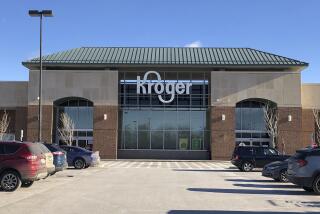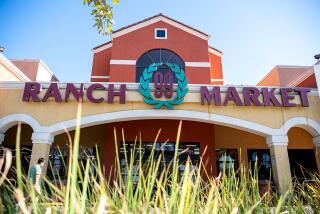Tesco to pull out of U.S. and sell Fresh & Easy markets
The British are leaving.
Five years after launching the Fresh & Easy grocery chain in the U.S., Tesco of England is abandoning its nearly $2-billion gamble.
Once called “foolhardy” by investment guru Warren Buffett, the ambitious experiment joins a sizable list of British ventures forced to admit defeat amid an American culture clash.
The failure of El Segundo-based Fresh & Easy Neighborhood Market, hastened by the recession, also highlights the difficulties of maintaining a foothold in a domestic grocery market already overrun by established, homegrown mega-brands such as Wal-Mart, Costco, Whole Foods and Trader Joe’s.
Tesco’s “inevitably painful decision to cut and run was correct,” said Neil Saunders, managing director of London research firm Conlumino, who observed that the company’s American foray will be remembered “as something of an unfortunate misadventure.”
“The bottom line is that Tesco probably bit off more than it could chew in the U.S.,” Saunders said.
Tesco’s announcement Wednesday of its “exit from the United States” confirms speculation sparked in December, when the British supermarket giant said it was conducting a strategic review of Fresh & Easy and its 200 stores in California, Arizona and Nevada.
The chain, which employs 5,000 people, failed to make any money during its run, losing more than $1 billion since opening its doors. To abandon the project, Tesco said, it will take a write-off of 1.2 billion pounds — or $1.8 billion.
Fresh & Easy is being shopped around to prospective buyers, Chief Financial Officer Laurie P. McIlwee said in a conference call with analysts. Tesco is “pursuing with earnest” several organizations interested in buying Fresh & Easy “in its entirety or virtually in its entirety,” he said.
The sale process will not be final for at least three months, McIlwee said. But Tesco expects to “be getting out of the U.S. without any further cash investments,” he said.
Analysts such as David Gray with market research firm Planet Retail are skeptical that Tesco will be able to shake off Fresh & Easy in one transaction.
Instead, he said, potential buyers such as Aldi Sud, Family Dollar Stores Inc. and Dollar General Corp., as well as possibly some drugstore companies, may try to snap up chunks of the chain. Fresh & Easy’s small size — about 10,000 square feet per store — may make it unappealing to big-box warehouse retailers such as Wal-Mart, whose average super center is 182,000 square feet.
Tesco’s many lease agreements with landlords also could give takeover contenders pause, he said.
The chain was beset by trouble almost from the start.
Tesco launched the brand in the U.S. in November 2007 — just as the country was about to topple into the recession and the subprime mortgage crisis, sending consumers into penny-pinching hibernation.
“You couldn’t have entered the Western U.S. at a worse time,” Gray said.
Fresh & Easy also had the unique problem of being both too small and too big, analysts said.
The chain maintained an expensive, 850,000-square-foot distribution center in Riverside County, capable of supporting 1,000 stores. With only 200 locations in the system, the investment went largely to waste, Gray said.
But building out so many shops in so short a time frame also hurt, said James F. Richardson, senior vice president of food industry consultancy Hartman Strategy.
The chain’s site selection was “uniformly odd,” he said, with stores set up mostly in suburban neighborhoods — many of them working class — where the housing crisis was especially painful.
It also failed to customize its stores to specific neighborhoods — a successful strategy for Whole Foods.
The competition alone could have crushed Fresh & Easy, which Richardson accused of “flopping in the middle conceptually” between an upmarket and discount ethos.
The $491.2-billion U.S. grocery business has some 35,870 players, including giants Kroger Co., Safeway Inc. and Supervalu Inc., according to research group IBISWorld.
Chains such as Whole Foods and Trader Joe’s already offered fresh organic foods and low-cost prepared meals. The companies also knew to buttress their good-for-you mantra by promoting local goods and touting their warm employee culture, analysts said.
Fresh & Easy, with its self-service checkout stands and homogenous product lines, “came across to everyone as a whiteboard concept,” Richardson said.
Beyond that, the chain didn’t offer much of a price incentive for consumers, who instead went to brands such as Food 4 Less, he said. The company also underestimated the power of the quick-service restaurant industry, with eateries such as Panera Bread and Chipotle making low-cost food easily accessible to consumers.
Jumping the Atlantic remains a tricky proposition for many British companies. J. Sainsbury, a giant in the British grocery industry, backed out of the U.S. when it sold Shaw’s Supermarkets to Albertsons in 2004. British retailer Marks & Spencer unloaded classic American brand Brooks Brothers in 2001 for a third of its buying price.
Under different circumstances, Fresh & Easy might have done better, Gray said. The chain’s sales steadily increased from 2009 through 2012, settling around $961 million last year, according to research group Mantel.
“Tesco is a very high-profile name and they’ve been so successful all over the world,” Gray said. “If one retailer was going to do it, you’d have thought it would have been Tesco.”
But Wednesday, for the first time in nearly two decades, the company said its fiscal year profit tumbled, tanking 96% to 120 million pounds, or $183 million, from 2.8 billion pounds, or $4.3 billion, a year earlier. Tesco managed a 1.4% boost in revenue to roughly $98.9 billion.
More than 5% of outstanding Tesco shares belong to Buffett, the billionaire known as the Oracle of Omaha through his work with his Berkshire Hathaway investment firm.
In addition to its U.S. retail flop, Tesco has struggled with Eurozone stability and a scandal surrounding horse meat-tainted beef. The company said last year that it would pull out of Japan and is dealing with unfavorable regulations in South Korea.
Tesco’s desertion disappointed some Fresh & Easy faithful, such as Van Nuys resident David Gilbert, 60, who said he shops regularly at a nearby store.
The UCLA librarian said he prefers the brand to the sprawling neighborhood Ralph’s, where he has to “walk by 10,000 things just to get from the bread to the milk.” He also said he enjoys Fresh & Easy’s selection and space compared with the perennially crowded local Trader Joe’s.
“We’re really sad,” he said. “We thought it was really great to shop there.”
More to Read
Inside the business of entertainment
The Wide Shot brings you news, analysis and insights on everything from streaming wars to production — and what it all means for the future.
You may occasionally receive promotional content from the Los Angeles Times.











